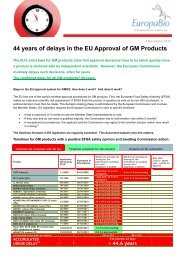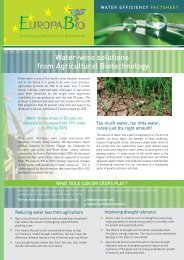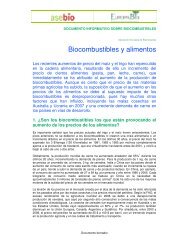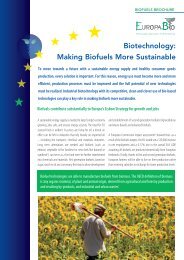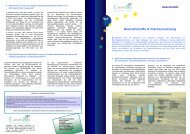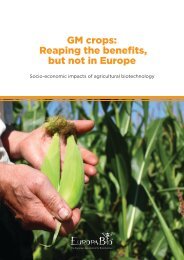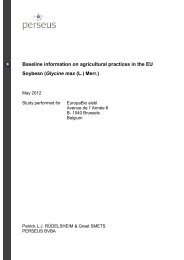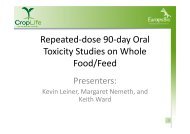Baseline information on agricultural practices in the EU ... - Europabio
Baseline information on agricultural practices in the EU ... - Europabio
Baseline information on agricultural practices in the EU ... - Europabio
You also want an ePaper? Increase the reach of your titles
YUMPU automatically turns print PDFs into web optimized ePapers that Google loves.
Nitrogen is essential for rapid expansi<strong>on</strong> of leaves. It <strong>the</strong>refore needs to present at seedl<strong>in</strong>g<br />
emergence. 70% of <strong>the</strong> crop‘s needs is taken up between <strong>the</strong> end of May and mid-July (ITB). By midseas<strong>on</strong><br />
<strong>the</strong> canopy has been formed and nutrients should be deviated to <strong>the</strong> root. Excess late<br />
nitrogen would still stimulate leaf growth and would have negative effects <strong>on</strong> root purity and sucrose<br />
c<strong>on</strong>tent and extracti<strong>on</strong>.<br />
As m<strong>in</strong>eralisati<strong>on</strong> of humus is limited early <strong>in</strong> <strong>the</strong> seas<strong>on</strong>, m<strong>in</strong>eral nitrogen is applied before sow<strong>in</strong>g<br />
and/or at early plant stage to meet <strong>the</strong> crop’s needs. About 2/3 rd is provided by sources <strong>in</strong> <strong>the</strong> soil,<br />
1/3 rd comes from <strong>the</strong> m<strong>in</strong>eral complement (ITB).<br />
Table 9: Average uptake of <strong>the</strong> most important nutrients by a sugar beet crop (IRS)<br />
nutrient<br />
uptake (kg/ha)<br />
root crown + leaf total<br />
nitrogen (N) 75 145 220<br />
phosphate (P2O5) 42 40 82<br />
potassium (K2O) 130 285 415<br />
sodium (Na2O) 12 130 142<br />
magnesium (MgO) 25 40 65<br />
The amount of nitrogen fertiliser fur<strong>the</strong>r depends <strong>on</strong> <strong>the</strong> type of <strong>the</strong> previous green manure crop, if<br />
any, whe<strong>the</strong>r livestock manure has been applied, and whe<strong>the</strong>r grass has been ploughed under (IRS).<br />
Often used green manure crops preced<strong>in</strong>g sugar beets are white mustard (S<strong>in</strong>apis alba), oil radish<br />
(Raphanus sativus subsp. oleiferus) and grass.<br />
M<strong>in</strong>eral fertiliser is applied 1-2 times; <strong>on</strong> sandy soils also manure is applied <strong>in</strong> spr<strong>in</strong>g (NL). On clay<br />
soils nitrogen is given already <strong>in</strong> February (IRS, ITB), sometimes <strong>on</strong>ly partly with <strong>the</strong> rest at <strong>the</strong> 2-6<br />
leaf stage. It is also possible to apply <strong>the</strong> total amount at <strong>the</strong> 2-leaf stage. Local applicati<strong>on</strong> <strong>in</strong> <strong>the</strong> row<br />
is also practiced to lower doses and to spare <strong>the</strong> envir<strong>on</strong>ment (ITB). On sandy soils <strong>the</strong> necessary<br />
m<strong>in</strong>erals are applied shortly before sow<strong>in</strong>g.<br />
Depend<strong>in</strong>g <strong>on</strong> whe<strong>the</strong>r <strong>the</strong> amount of phosphorus stored <strong>in</strong> <strong>the</strong> soil is sufficient or not, applicati<strong>on</strong> is<br />
d<strong>on</strong>e <strong>in</strong> autumn or spr<strong>in</strong>g time (to keep level), or <strong>in</strong> spr<strong>in</strong>g respectively. On clay soils potassium is<br />
provided preferably <strong>in</strong> autumn, <strong>on</strong> light soils spr<strong>in</strong>g time is <strong>the</strong> optimum period.<br />
Sodium sometimes has a positive effect <strong>on</strong> root mass and sugar c<strong>on</strong>tent, especially <strong>on</strong> sandy soils<br />
(IRS). Light soils also are sensitive for magnesium deficiency. On clay soils magnesium is sprayed<br />
when deficiency symptoms become visible.<br />
Bor<strong>on</strong> deficiency causes heart rot. Aga<strong>in</strong> sandy soils are most vulnerable. A field with a history of<br />
bor<strong>on</strong> deficiency should receive e.g. borax before sow<strong>in</strong>g. Alternatively leaf fertilisers are sprayed<br />
between <strong>the</strong> 2-leaf stage and crop closure.<br />
Farmers usually base <strong>the</strong>ir calculati<strong>on</strong>s for <strong>the</strong> optimum fertilisati<strong>on</strong> <strong>on</strong> soil analyses from samples<br />
taken <strong>in</strong> w<strong>in</strong>ter. Several <str<strong>on</strong>g><strong>in</strong>formati<strong>on</strong></str<strong>on</strong>g> services provide models and advice to calculate <strong>the</strong> right dose of<br />
fertilisers to apply <strong>in</strong> <strong>the</strong> fields as this may differ from <strong>on</strong>e field to ano<strong>the</strong>r. Examples are: Fert-C<strong>on</strong>sult<br />
(Belgium); Fertibet and Azofert (France); LIZ-Dungpro and BISZ Düngung (Germany); Integrated Beet<br />
Nutriti<strong>on</strong> - N.I.B. (Italy); Betakwik N-P-K (<strong>the</strong> Ne<strong>the</strong>rlands) (CIBE-CEFS, 2010).<br />
The general practice to prepare <strong>the</strong> soil is plough<strong>in</strong>g <strong>in</strong> order to <strong>in</strong>corporate crop residuals and weeds<br />
<strong>in</strong> <strong>the</strong> soil. On heavy soils this is d<strong>on</strong>e <strong>in</strong> autumn with <strong>the</strong> advantage that frost can break clods (Table<br />
10). On sandy soils plough<strong>in</strong>g and seedbed preparati<strong>on</strong> is often d<strong>on</strong>e <strong>in</strong> <strong>on</strong>e operati<strong>on</strong> or <strong>the</strong> soil is<br />
tilled shortly before prepar<strong>in</strong>g <strong>the</strong> actual seed bed. Local legislati<strong>on</strong> might restrict soil preparati<strong>on</strong>s to<br />
prevent erosi<strong>on</strong>. For <strong>the</strong> seedbed <strong>the</strong> soil needs to be moist and have a f<strong>in</strong>e structure <strong>in</strong> <strong>the</strong> top 3 cm<br />
layer.<br />
Page 26 of 66



